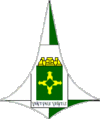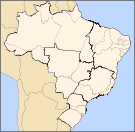Brasília
2007 Schools Wikipedia Selection. Related subjects: Central & South American Geography
| Brasília | |||||
|
Image:Brasiliaaa.jpg Brasília skyline |
|||||
|
|||||
| Location of Brasília | |||||
| Coordinates: | |||||
|---|---|---|---|---|---|
| Country | Brazil | ||||
| State | Distrito Federal | ||||
| Governor | Maria de Lourdes Abadia | ||||
| Area | |||||
| - City | 5,801,937 km² | ||||
| Elevation | 1000 m | ||||
| Population | |||||
| - City ( 2005) | 2,333,108 | ||||
| - Density | 353,53/km² | ||||
| Time zone | UTC ( UTC-3) | ||||
| Website: www.brasilia.df.gov.br | |||||
Brasília is the capital of Brazil with a population of 2,333,108 . Located in the Brazilian Federal District, the city is famous for its urban planning, daring architecture and rapid population growth. In English, the diacritical mark on the í is often omitted and the name written Brasilia.
Location
Brasília is in a Federal District, created by Juscelino Kubitschek within the state of Goiás. The District is bordered by the Preto River to the east and by the Descoberto River to the west. Brasília is situated on Planalto Central, a 1000 m high plateau. Brasília is 207 km from Goiânia, 1,531 km from Salvador, 930 km from Rio de Janeiro, 716 km from Belo Horizonte and 1,015 km from São Paulo.
Climate
Brasília has dry winters and wet summers. During the dry season, the relative humidity of the air reaches critical levels during the hottest times of the day. Maximum temperatures average 28°C (82°F). During the dry season the temperature decreases and can reach daily lows of 13°C (55°F) in July. Maximum averages of 25°C (77°F) are the norm.
The average temperature is 20.5°C (69°F). The hottest month is September, with an average high of 28°C (82°F) and an average low of 16°C (61°F). The coolest month is July, with an average high of 25°C (75°F) and an average low of 13°C (55°F). The monthly difference between the average high is around 3°C (35°F) and the average low 5°C (39°F).
The absolute minimum registered was 0.5°C (33°F) and the maximum absolute 34.1°C (93°F).
Government
The federal district has an autonomous government and legislative powers, but the judiciary is upheld by the Union. The District Governor is elected directly for a 4-year term. Local laws are issued by a legislative assembly also elected by the local population. The district also has the status of a federal state in many aspects. It has representatives both in the Lower House of Congress (Câmara Federal) and in the national Senate.
Moreover, Brasília is home to the country's federal government. The executive branch is represented by the Palácio do Planalto (presidential workplace) and the various Ministries that are located along the Monumental Axis. The legislative and judicial powers are also located there.
A Planned City
History
President Juscelino Kubitschek ordered the construction of Brasília, enacting a long-forgotten article of the country's republican constitutions stating that the capital should be relocated from Rio de Janeiro. Its main urban planner was Lúcio Costa. Oscar Niemeyer was the chief architect of most of the public buildings and Roberto Burle Marx was the landscape designer. The city plan was based on the ideas of Le Corbusier. Brasília was built in 41 months, from 1956 to April 21, 1960 when it was officially inaugurated.
From 1763 to 1960, Rio de Janeiro was the capital of Brazil, and resources tended to be centred in Brazil's southeast region. Brasília’s geographically central location made for a more regionally neutral federal capital. The idea of placing Brazil’s capital in the interior dates back to the first republican constitution of 1891, which roughly defined where the federal district should be placed, but the site itself was not defined until 1922. Brasília’s location would promote the development of Brazil's central region and better integrate the entire territory of Brazil.
According to legend, in 1883, the Italian priest Don Bosco had a prophetic dream in which he described a futuristic city that roughly fitted Brasília's location. Today, in Brasília, there are many references to this educator who founded the Salesian order. One of the main cathedrals carries his name.
Design
Lúcio Costa’s plan for the city was detailed and thorough. It stipulates which zones are to be residential and which are to be commercial. It limits where industries can settle, where certain buildings can be built and how tall those buildings can be, etc.
The basis of the plan for the city was a simple cross. In the word of Costa: the project "was born from the primary gesture of someone who signs a place of take its ownership: two axes crossing themselves in right angle, the sign of the cross, itself". However, the cross had to be adapted to the local topography, as there were already plans for the artificial lake, and the city gained the shape of an airplane.
The fuselage of the aeroplane contains the ministries, government buildings, the Senate and Chamber of Deputies and a futuristic cathedral, designed by Oscar Niemeyer. There is also a tall television tower, with spectacular views of the city and the lake.
The wings of the airplane are named the North Wing and South Wing: each is roughly seven kilometers in length. The avenue between the lake and the wings is called L4 Sul or L4 Norte, depending on which wing.
A wide, high-speed avenue, called the Eixo Rodoviário, connects the two wings by passing under a central bus station, where the banking sector (Setor Bancário) and hotel sector (Setor Hoteleiro) are located. The 100s and 300s addresses are on the west side of the Eixo, and 200s and 400s are on east side. There are residential areas on these streets made up of blocks of flats, named Super Quadra Sul or Super Quadra Norte. The blocks are filled with three or six-storey buildings. Each has eleven buildings, identified by letter, with schools and churches in areas placed in between them. Commercial streets typically separate Superquadra blocks from each other.
There is also a zoo close to Brasilia's Airport with animals native to the Cerrado area. Embassies, recreational clubs and luxury homes surround the lake, and an enormous park, called the ' Parque da Cidade' (City Park), gives much-needed space for cycling, jogging and contact with nature.
One major criticism of Brasília is that it was not designed on a pedestrian scale. Pedestrians were not taken much into consideration during the advent of the motor age, when the city was developed. In the original plan there were no traffic lights - all cars travelled over overpasses and through tunnels to avoid intersecting traffic. Today, with 200,000 people living in the Plano Piloto (the Pilot Plan), the plan soon became out-dated, but the city found a solution in education: thousands of pedestrian stripes were painted in every street, shortening the way of the pedestrians. A metro has been built recently to alleviate these problems, but there are several unfinished stations yet. A line was completed for the South Wing, which continues to the major satellite city of Taguatinga. Whilst public transportation is almost plentiful, the car remains popular as a means of transportation in Brasília.
Another criticism of Brasília is the displacement of poor residents too far away in satellite towns like Santa Maria, São Sebastião, Gama, Ceilândia and Sobradinho. Buses and a surface rapid transit system connect these cities to the centre. Inhabitants of these satellite towns live in conditions inferior to those of the Pilot Plan due to the habitation policy adopted by Governor Joaquim Roriz, in which people from other poor regions of the country were attracted to the capital in exchange for a little estate, overfilling the Federal District boundaries. When one talks of Brasília, these satellite cities are rarely taken into consideration, even though their population far surpasses that of the Pilot Plan. Still, Brasilia is the city that has the highest HDI in Brazil.
According to the original plan -- which Brasília must follow -- the city is constantly under construction.
UNESCO has declared Brasília a World Heritage Site.
Nightlife
Although Brasilia lacks the nightlife infra-structure and standards of other major Brazilian cities such as Rio de Janeiro and São Paulo, creativity has helped to combat boredom. The city hosts musical talents such as Legião Urbana, Capital Inicial and Cássia Eller. There are places in the city such as the "Setor de Diversões Sul", also known as Conic, next to the Pátio Brasil mall.
Famous people born in Brasília
- Leila Barros, volleyball player
- Rebeca Gusmão, swimmer
- Kaká, footballer (current club A.C Milan)
- Lúcio, footballer (current club Bayern Munich)
- Tatiana Lemos, swimmer
- Ana Paula Padrão, journalist
- Hudson de Souza, middle distance runner.,(max.5000m)
- Marílson Gomes dos Santos, professional athlete, winner of the New York City Marathon ( 2006)





